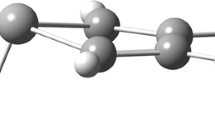Abstract
In a previous article (8) a geometrical study of the five-membered ring showed that: a) for the case of the 20 symmetrical C2 and Cs conformations, the pseudorotation formulae for the torsion angles are a geometrical property of the ring; b) geometrical considerations alone are unable to define the puckering amplitude, the bond angle values, and the pathway between two symmetrical conformations. Here we examine how the energy equations enable us to define the deformation amplitude χ m, establish the bond angles expressions and check the energy invariability along the pseudorotation circuit. The problem is next developed fully in the case where the bond and torsional energy only are considered: the literal expression1 of χ m is then given as a function of the bond angle Ω which cancels out the bond angle energy. A numerical application is carried out on cyclopentane and the values of the parameters Kt, K1 and Ω used in the Conformational energy calculations are considered.
Similar content being viewed by others
Abbreviations
- 1 i :
-
bond lengths ≡ 1 in the case of the regular ring
- χ i :
-
torsional angles
- Φ i :
-
bond angles
- Φ :
-
3π/5 = 108‡
- δ :
-
4π/5 = 144‡
- ɛ, i :
-
Φ i − Φ= complement to the 108‡ bond angle Φ i
- ɛ T :
-
∑
- E :
-
Conformational energy of the 5-membered ring
- δE :
-
Conformational energy difference between planar and deformed ring
- A n :
-
Coefficients of the energy development in terms of ∑
- E li :
-
Bond energy relative to atom i (associated with angle Φ i)
- K li :
-
Bond constant relative to atom i (associated with angle Φ i)
- E li :
-
Torsional energy relative to the i th bond (associated with angle χ i)
- k li :
-
Torsional constant relative to the i th bond (associated with angle χ i)
- Ω i :
-
Angle Φ i value corresponding to zero bond energy E li (when the 5 atoms of the ring are identical, Ω i ≡ Ω)
- r ij :
-
Distance between atoms i and j
- q i :
-
Charge carried by atom i
- e :
-
Constant of proportionality including the effective dielectric constant
- A ij, Bij, dij :
-
Coefficients dependent on the nature of the atoms i and j and accounted for in the Van der Waals energy and hydrogen bond expressions
- S (r ij):
-
Electrostatic contribution to the hydrogen bond energy
- P :
-
Pseudorotation phase angle
- χ m :
-
Maximum torsional angle value characterising the deformation amplitudeM
References
Altona C (1971) Geometry of five membered rings. In:Chiurdoglu R (ed) Conformational analysis. Scope and present limitations. Academic Press, New York London
Kilpatrick JE, Pitzer KS, Spitzer R (1947) The thermodynamics and molecular structure of cyclopentane. J Am Chem Soc 69:2483–2488
Hendrickson JB (1961) Molecular Geometry. I. Machine computation of the common rings. J Am Chem Soc 83:4537–4547
Geise HJ, Altona C, Romers C (1967) The relations between torsional and valency angles of cyclopentane. Tetrahedron Lett 15:1383–1386
Lifson S, Warshel A (1968) Consistent force field for calculations of conformations, vibrational spectra, and enthalpies of cycloalkane and n-alkane molecules. J Chem Phys 49:5116–5129
Dunitz JD (1972) Approximate relationships between conformational parameters in 5- and 6-membered rings. Tetrahedron 28:5459–5467
Altona C, Geise HJ, Romers (1968) Conformation of non aromatic ring compounds-XXV-geometry and conformation of ring D in some steroids from X-rays structure determinations. Tetrahedron 24:13–32
Abillon E (1982) Geometry of the five-membered ring. Mathematical demonstration of the pseudorotation formulae. Biophys Struc Mech 8:257–270
Scheraga HA (1968) Calculations of conformations of polypeptides. Adv Phys Org Chem 6:103–184
McCullough JP, Pennington RE, Smith JC, Hossenlopp IA, Waddington G (1959) Thermo-dynamics of cyclopentane, methylcyclopentane and 1, cis-3-dimethylcyclopentane:Verification of the concept of pseudorotation. J Am Chem Soc 81:5880–5883
Bixon M, Lifson S (1967) Potential functions and conformations in cycloalkanes. Tetrahedron 23:769–784
Hendrickson JB (1967) Molecular geometry-V-evaluation of functions and conformations of medium rings. J. Am Chem Soc 89:7036–7046
Pitzer KS, Donath WE (1959) Conformations and strain energy of cyclopentane and its derivatives. J Am Chem Soc 81:3213–3218
IUPAC-IUB Commission on biochemical nomenclature (1969) Handbook of biochemistry, A-25–A-35
Author information
Authors and Affiliations
Rights and permissions
About this article
Cite this article
Abillon, E. Conformational energy of the 5-membered ring. Implication of geometric and energetic properties in the conformational characteristics. Biophys. Struct. Mechanism 9, 11–27 (1982). https://doi.org/10.1007/BF00536012
Received:
Accepted:
Issue Date:
DOI: https://doi.org/10.1007/BF00536012




